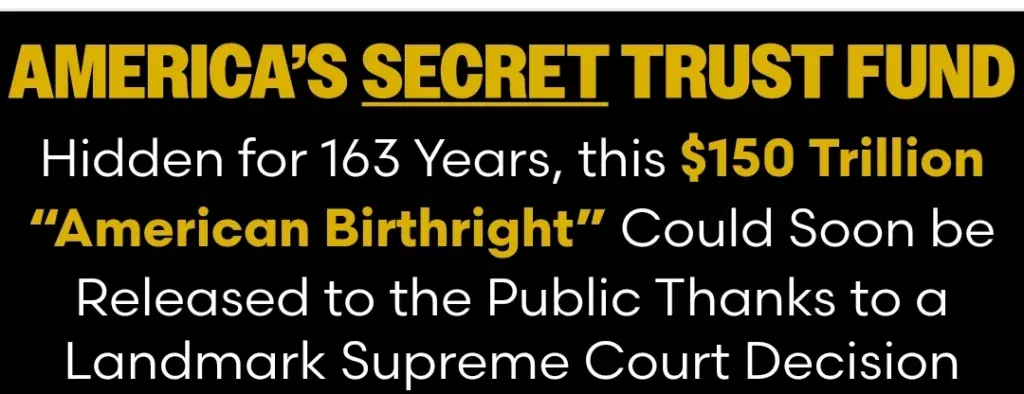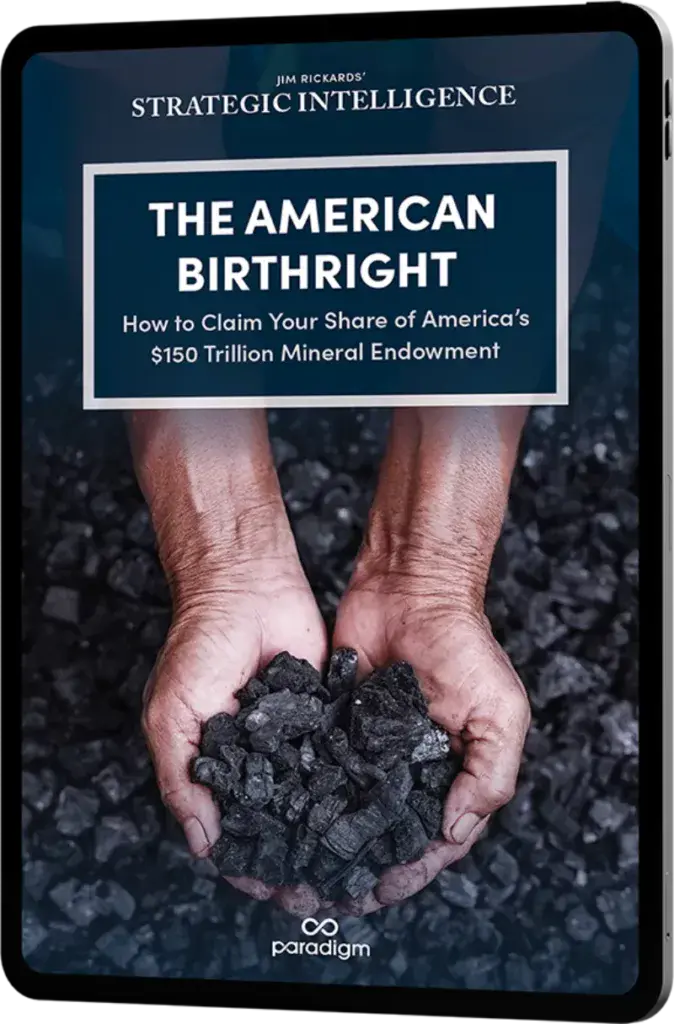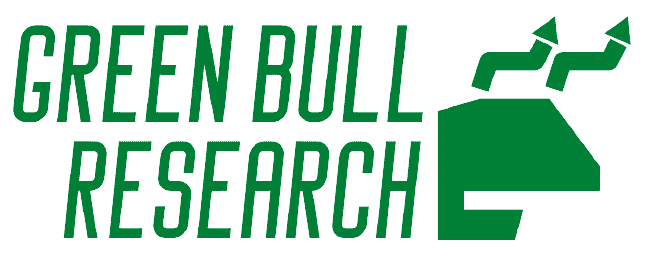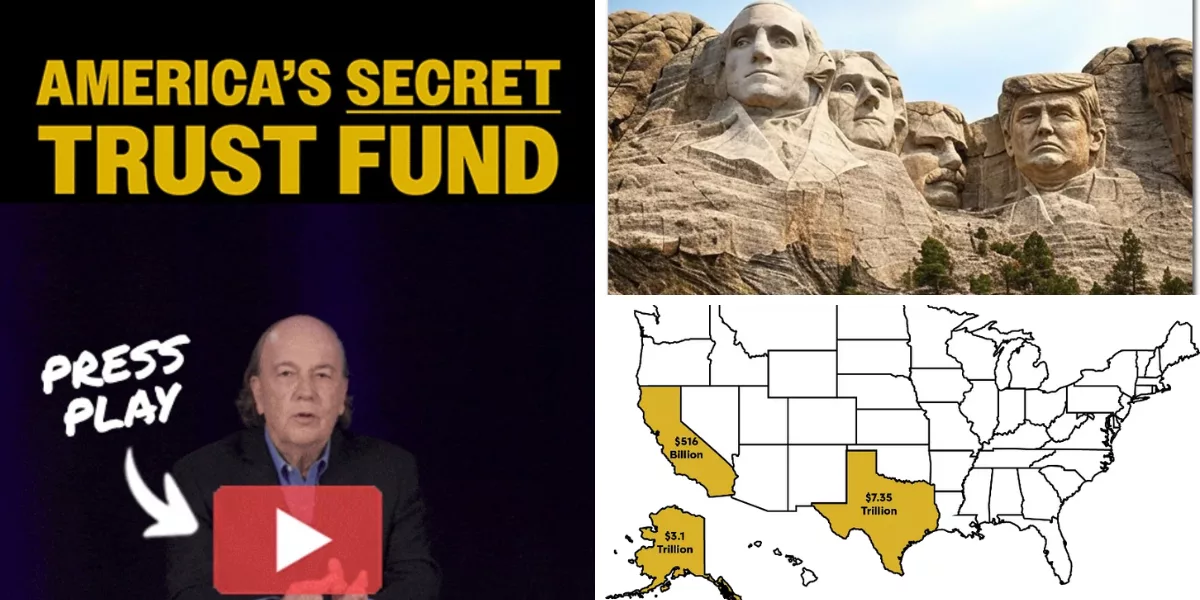One of the most politically connected men in the world, Jim Rickards, believes “America is anything but broke.”
Instead, he says the 42nd Congress changed Title 30 of the U.S. Code to establish a “secret trust” that has quietly grown into a fifteen-figure fortune, and it is an American Birthright for every citizen.
The Teaser
For more than a century, it was sealed off from the public. But now, thanks to a Supreme Court Decision, it will soon be unlocked.

Of all the strategists, analysts, and get-rich quick schemers we regularly cover here on Greenbull, Jim Rickards' resume is as impressive as any of them.
He is a former practicing attorney, investment banker, consultant, author, newsletter editor, man, and myth who we previously did a deep dive on, see Is Jim Rickards A Fraud? And whose past pitches we have also reviewed, Jim Rickards' AI Prediction.
The start of this one sounds like the plot of a new Indiana Jones adventure.
However, Jim assures that this “national trust” of $150 trillion and counting is real.
If you're as skeptical as I am, keep reading, because we're about to get to the bottom of this financial mystery.
The $150 Trillion “Trust” No One Talks About
As someone with a law degree from the University of Pennsylvania, who has passed the bar, Jim points to sections 22 to 42 of U.S.C. Title 30.
I looked it up and these particular sections pertain to Mineral Lands and Mining.
This passage from the document is also telling:
All valuable mineral deposits in lands belonging to the United States, both surveyed and unsurveyed, shall be free and open to exploration and purchase
It sounds like Jim is talking about the country's vast untapped mineral wealth.
Our suspicions are confirmed when Jim states that “this isn't about a pile of stocks, cash, bonds real estate, or gold bars.”
Nor is it an actual “trust fund” or “endowment,” but rather it's about the building blocks of life…mineral wealth.
Now that we know this is as real as life once you turn 21, now may be our chance to get rich through a few little-known companies that are set to become household names, in the years ahead.
The Pitch
The names of these companies have been compiled in a research report called The American Birthright: How to Claim Your Share of America’s $150 Trillion Mineral Endowment.

We can hold it in our hands like the coal miner in the image, with a subscription to Jim's Strategic Intelligence newsletter.
It usually costs $299 upfront for 6 months, but the price is being lowered to $49 for the first six months, with a 90-day money-back guarantee.
The 21st Century Gold Rush
There hasn't been a real mining boom since the early 1900s.
Sure, we have the shale oil boom, but that has been more due to the innovation of hydraulic fracturing and horizontal drilling, than anything else.
The reason more gold, silver, copper, lithium, and other minerals haven't been dug up isn't due to an unwillingness to mine, but rather, by design.
For the past 50 years or so, Washington has prioritized electric cars, solar panels, and offshore windmill farms to minerals that make the world go round.
The end result of such policy has been trillions of dollars in taxpayer costs, reliance on China for key minerals, and little to no positive environmental impact, which was the whole point of it to begin with.
Thankfully, it is now changing.
The Chevron Doctrine
I had never heard of this policy before, but it involves the oil and gas company of it's namesake, a 1984 Supreme Court decision, and federal agencies. Sounds like a wild Saturday games night.
Chevron U.S.A. Inc. v. Natural Resources Defense Council, Inc., was a landmark case that laid the groundwork for where we are today.
In plain language, it established the precedent that U.S. federal courts must defer to a federal government agency's interpretation of a law or statute.
This is what enabled the federal government to veto mining projects for so long, but last year, Trump’s Supreme Court overturned the Chevron Doctrine.
Now, its moving fast to unlock the estimated $150 trillion in dormant underground wealth.

For the first time in nearly a century, mineral-rich Federal Lands that add up to roughly 28% of the country's total landmass, are being made available for exploration.
Not only this, but the projects that will recover these long-dormant resources are being fast-tracked, and Jim knows the best ones to invest in.
Jim Rickards' American Birthright Businesses
Jim teases five companies he believes will skyrocket in the years to come.
However, that's about all he does, because no follow-up clues are given about any of his “tiny mining firms that control massive deposits.”
Never ones to give up and call it a day's work early, we dug a bit deeper, and found some possible answers.
We know that the most recent installment of critical mineral production projects to be fast-tracked by the Trump admin was in early May. This is in addition to the initial group of 10 projects announced on April 18th.
It would make sense that, at least some of Jim's picks, would be among this second batch.
He did say “tiny”, so we're only looking for micro and small cap stocks with valuations below $2 billion.
These are the ones that made the cut:
- Energy Fuels Inc. (NYSE American: UUUU). Barely made the shortlist, with a $1.95 billion market cap. It owns one of the highest-grade uranium projects in the country.
- Paramount Gold Nevada Corp. (NYSE American: PZG). The only microcap on the list, at a $60 million valuation. It's the owner of the Grassy Mountain Gold Mine Project in eastern Oregon.
- The Chemours Company (NYSE: CC). At $2.1 billion, we made an exception with this one, because it pays a 2.4% dividend, and it just got its Amelia A&B minerals project fast-tracked.
We can't confirm that any are among Jim's five picks, but they keep with the spirit of what he's teasing.
The bigger question is, how accurate is Jim's investment thesis?
American Birthright or Illusion?
Jim isn't the first and he very likely won't be the last investment newsletter purveyor to tease a mineral boom.
At the most fundamental level, it's what makes artificial intelligence possible, so it will continue to be a central investment theme.
So, is Jim's reasoning about the end of the Chevron Doctrine, Trump's series of Executives Orders, and resource-hungry AI equating to a new gold rush right?
For the most part, I would say he's on the money.
Cutting red tape and clearing the path for businesses to create value is the way forward, and the full impact of these actions will be felt in a few year's time.
The only questionable claim is the $150 trillion figure for untapped mineral reserves, which Snopes also noted was cited without any sources.
It appears to simply be estimated based on a 2013 Institute for Energy Research (IER) report, with inflation added to the original $128 trillion figure.
Regardless of what the actual figure is, owning land, mineral rights, and royalties in producing properties – hard assets, and holding onto them for the long term is one of the most tried and true ways to build wealth.
Quick Recap & Conclusion
- One of the most politically connected men in the world, Jim Rickards, is teasing a “$150 trillion secret trust” that is an American Birthright for every citizen.
- It turns out that Jim pulled a Federal Reserve on us, as there is no secret trust or birthright to one, just like the Fed isn't Federal, and it has no reserves.
- Instead, what Jim is really promoting here are five companies benefiting from the Trump administration's fast-tracking of mineral exploration permits. Their names are only revealed in a research report called The American Birthright: How to Claim Your Share of America’s $150 Trillion Mineral Endowment.
- Jim played this one cool and didn't provide a single clue about any of his picks, but we did provide some educated guesses on what some could be, based on the most recent batch of mineral projects to be fast-tracked by the Trump admin.
- $150 trillion in untapped mineral reserves may be a stretch, but demand for them is poised for above-average growth thanks to AI, and owning even a small stake in producing properties could generate multibagger returns.
How much mineral wealth do you estimate America really has? Drop your best guesses in the comments.

